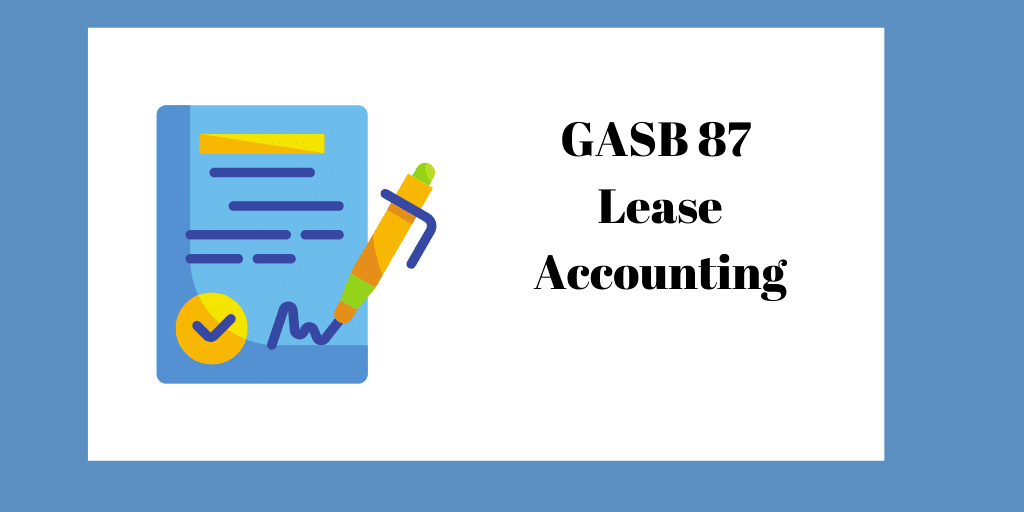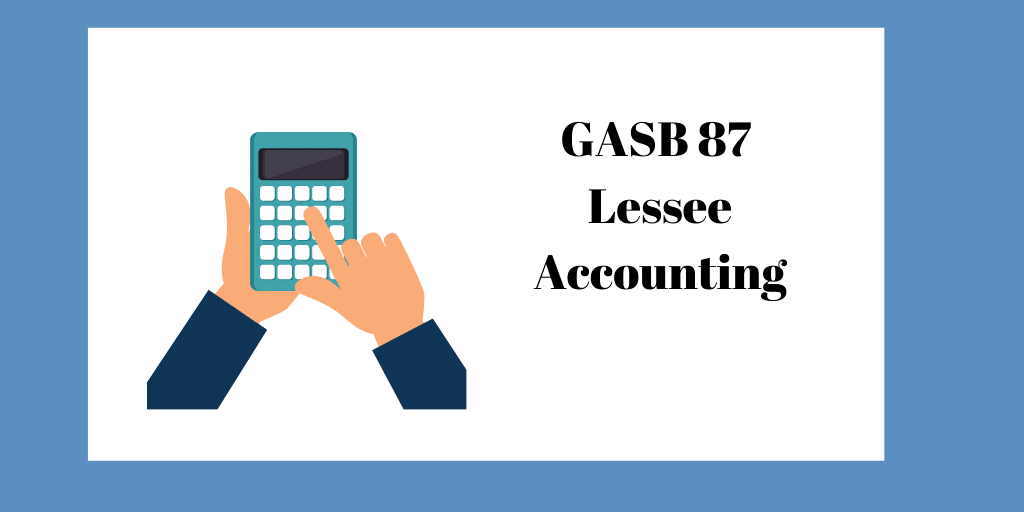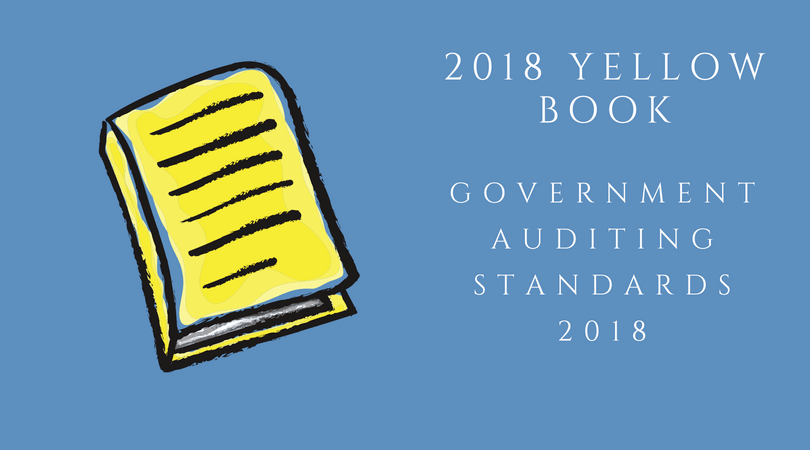Are you looking for GASB 87 lease accounting information? Are you a government that leases assets? Then you're in the right place. Below I provide information about lease terms, discount rates, accounting entries, and disclosure requirements.
Removal of Bright-Line Criteria
Historically governments have followed the guidance in FASB 13, Accounting for Leases. Lease classifications (i.e., operating or capital) were based on bright-line criteria such as whether the government leased an asset for more than 75% of its economic life.
GASB 87, Leases, removes the bright-line criteria and calls for more judgment. (The words reasonably certain appears thirty-nine times in GASB 87.)
The new lease standard provides for various accounting alternatives. Let's see what they are.
Three Potential Accounting Alternatives
Regarding leases, there are now three accounting alternatives:
- Short-term leases
- Contracts that transfer ownership
- Contracts that do not transfer ownership
Before we dive deeper, here are three quick points about these alternatives:
First, know that short-term leases do not create a lease liability.
Second, understand that contracts that transfer ownership are a financed sale.
Third, know that contracts that do not transfer ownership create a lease liability. This third category is a catchall for arrangements that don't qualify for short-term lease treatment and don't transfer ownership.
Now, let's see how GASB defines a lease.
Definition of a Lease
GASB defines a lease this way:
A lease is defined as a contract that conveys control of the right to use another entity’s nonfinancial asset (the underlying asset) as specified in the contract for a period of time in an exchange or exchange-like transaction.
There are five points to this definition:
First, the lease must be a contract.
Second, the contract must provide control of the right to use.
Third, this control is in relation to a nonfinancial asset.
Fourth, the control of the nonfinancial asset must be for a period of time.
And finally, the lease is an exchange or exchange-like transaction.
I think the terms contract, period of time, and exchange are easily understood. But the terms control and nonfinancial assets might cause some confusion. So let's clarify those.
Control
A government controls an asset if it has the right to the present service capacity and the right to determine the nature and manner of use of the asset.
In other words, the government must have the right to the benefits generated from the asset. A city can drive a leased police car. That is the benefit, the present service capacity.
Additionally, Nature and manner address whether the government controls the use of the asset. A city police officer can, for example, drive a leased police car at 3:00 a.m. And she can drive it as far as she likes. The police department determines the nature and manner of use.
Nonfinancial Asset
And what is a nonfinancial asset? It's generally anything that is not a financial asset (e.g., cash, receivable). Examples of nonfinancial assets include buildings, land, vehicles, and equipment. There are exceptions, however.
GASB 87 Scope Exclusions
GASB 87 does not apply to:
- Leases of intangible assets (e.g., rights to explore for oil and gas)
- Leased biological assets (e.g., timber)
- Inventory that is leased
- Service concession arrangements
- Leases in which the underlying asset is financed with outstanding conduit debt (unless the underlying asset and the conduit debt are reported by the lessor)
- Supply contracts (e.g., power purchase agreements)
Now let's see how to determine the lease term.
Lease Term
Prior to GASB 87, the minimum lease payments determined the lease term. Not so any more. In some cases, GASB 87 provides for a more subjective determination of a lease's term, one based on what is reasonably certain.
Lease Options
Under GASB 87, lease terms are not just the noncancelable portion of the agreement. Governments add the following to the noncancelable period:
- Periods covered by a lessee’s option to extend the lease if it is reasonably certain, based on all relevant factors, that the lessee will exercise that option
- Periods covered by a lessee’s option to terminate the lease if it is reasonably certain, based on all relevant factors, that the lessee will not exercise that option
- Periods covered by a lessor’s option to extend the lease if it is reasonably certain, based on all relevant factors, that the lessor will exercise that option
- Periods covered by a lessor’s option to terminate the lease if it is reasonably certain, based on all relevant factors, that the lessor will not exercise that option.
Reasonably Certain Factors
In determining what reasonably certain is, the government considers factors such as the economic impact of not exercising an option or how the government has acted in the past.
Once the lease term decision is made, document your basis for doing so. Why? So there is a record of the decision. (Your auditors may want to see this. Additionally, the record provides valuable information regarding future lease term decisions.)
Fiscal Funding Clauses Affect on Term
Additionally, you may be wondering if fiscal funding clauses affect leases. (Fiscal funding clauses allow a government to cancel a lease if the government does not appropriate funds for the payments.) If a government is reasonably expected to exercise such a provision, then this factor can impact the lease term. Personally, however, I've never seen a government terminate a lease through such a provision. Fiscal funding clauses will usually not affect lease terms.
So, should governments ever reassess the term period?
Reassessment of Term
Government will generally not reassess the lease term decision.
Nevertheless, reassessment will occur in some cases. Consider this example. The government enters into a fifteen-year lease with a five-year lease extension. The government believes that it will not exercise the five-year extension. But then in year fifteen, it does so. Now the government binds itself for another five years. Therefore, the lease is extended. And the additional five years is added to the lease term.
Now that you know about lease terms, you may be wondering about short-term leases. How does a government account for those?
Short-Term Leases
Treat leases with a maximum possible term of twelve months or less as short-term leases. And do not capitalize such leases.
One word of caution: if there are renewal options, include those in making the short-term lease classification decision, regardless of probability. If, for example, the lease is for twelve months with an option to renew for another six months, then the lease is not short-term. Even if the government believes it will not exercise the option.
So, how do you record short-term lease payments? As expenses.
Contract that Transfers Ownership
If an agreement transfers ownership of the asset to the lessee by the end of the contract, then the contract is a financed purchase. For the lessee, the government records the purchased asset (not an intangible) and the related debt (not a lease liability).
So, what about a lease agreement with a bargain purchase option? Should it be treated as financed purchase? The answer is no. The presence of a bargain purchase option in a lease contract is not the same as a provision that transfers ownership of the underlying asset.
Multiple Components of a Lease Contract
If an agreement has lease and non-lease components, split the transaction.
A government might, for example, lease floors four and five of a ten-story building. In doing so, it is required to pay for common area maintenance. Split this transaction into a lease and a maintenance contract. Record the lease exclusive of the maintenance payments. If, however, it is not practicable to determine the separate price allocation, the government should account for the transaction as a single lease.
If a lease involves multiple underlying assets (say a police car and a water tank), the government should account for each as a separate lease component.
Lessee Accounting
If the government is leasing an asset, then it will use the following guidance. (An exception exists if the lease is short-term as explained above.)
Initial Recognition
At commencement, the government recognizes an (1) intangible right-to-use asset and (2) a lease liability.
So the government does not recognize the asset itself (e.g., tractor), but the right to use the asset. This is an intangible asset.
Now let's see how to compute the lease asset.
1. Lease Asset
So. what goes in the lease asset calculation?
The government should include:
- Initial lease liability (see below)
- Payments made to lessor at or before commencement less any lease incentives received from the lessor at or before the commencement of the lease term
- Initial direct costs that are ancillary charges necessary to place the lease asset into service
So what costs are not included in the intangible asset? Governments should exclude any debt issuance costs.
Notice that the lease asset can be greater than the lease liability. The lease asset starts with the lease liability and increases if, for example, the government makes a payment to the lessor prior to commencement of the lease term.
In governmental funds (e.g., general fund), the initial accounting entry is a debit to capital outlay and a credit to other financing sources. In full accrual funds (e.g., enterprise fund), the initial entry is a debit to the intangible lease asset and a credit to the lease liability.
So, how should the lease asset be amortized?
Lease Asset Amortization
Amortize the lease asset in a systematic and rational manner over the shorter of the lease term or the asset's useful life. Usually this will be straight-line amortization.
And what are the journal entries for recording the lease asset?
Lease Asset Accounting
The government records the lease asset and then amortizes it using an entry such as the following (for full-accrual funds; e.g., water and sewer fund):
Account
Amortization Expense
Accumulated Amortization - Right-of-Use Asset
GASB 87 says to report the amortization as an outflow of resources (e.g., amortization expense). The amortization expense can, for financial reporting purposes, be combined with the depreciation expense of other capital assets.
Modified accrual funds (e.g., general fund) will not record an amortization entry. Why? The asset does not appear on the balance sheet.
2. Lease Liability
How does a government compute the lease liability?
Simply put, the lease liability is the present value of everything you think you're going to pay. Prior to GASB 87, governments used the present value of minimum lease payments. Now governments include payments that are reasonably certain. (See information above regarding what is reasonably certain.)
The computation is made up of the present value of:
- Fixed payments
- Variable payments that depend on an index or a rate (e.g., consumer price index) measured using the index or rate as of the commencement of the lease
- Variable payments that are fixed in substance
- Amounts that are reasonably certain of being required to be paid by the lessee under residual value guarantees
- The exercise price of a purchase option if it is reasonably certain that the lessee will exercise that option
- Payments for penalties for terminating the lease
- Any lease incentives receivable from the lessor
- Any other payments that are reasonably certain of being required based on an assessment of all relevant factors
Variable Payments Based on Future Performance
Governments will not include payments based on future performance or usage in the lease liability. Expense such payments in the period incurred.
For example, if a government leases a vehicle with a provision for 12,000 miles annually but the car is driven 15,000 miles, expense the payment for the additional mileage as incurred.
So, where does the discount rate come from?
Discount Rate
Use the rate charged by the lessor if specified in the agreement. If not specified, use the incremental borrowing rate for the government. This is the estimated rate the government would pay if, during the life of the lease, it borrowed the funds for those lease payments.
Lease Liability Accounting
Once the initial lease is recorded as a liability, the government will begin making periodic payments to the lessor. The effective interest rate method will be used. Record the payments as follows (for full-accrual funds; e.g., water and sewer fund):
Account
Lease liability
Interest Expense
Cash
Post the payments to principal and interest expenditures in modified accrual accounting funds (e.g., general fund).
GASB 87 Disclosures
The following disclosures are required for lessees:
- A general description of its leasing arrangements
- The total amount of lease assets, and the related accumulated amortization, disclosed separately from other capital assets
- The amount of lease assets by major classes of underlying assets, disclosed separately from other capital assets
- The amount of outflows of resources recognized in the reporting period for variable payments not previously included in the measurement of the lease liability
- The amount of outflows of resources recognized in the reporting period for other payments (e.g., termination penalties) not previously included in the measurement of the lease liability
- Principal and interest requirements to maturity, presented separately, for the lease liability for each of the five subsequent fiscal years and in five-year increments thereafter
- Commitments under leases before the commencement of the lease term
- The components of any loss associated with an impairment
Transition
Apply GASB 87 retroactively, if practicable, for all periods presented. Use the facts and circumstances existing at the beginning of the implementation period to record the leases.
The notes to the financial statements should disclose the nature of the restatement and its effect.
GASB 87 says that the provisions of this statement need not be applied to immaterial items.
GASB 87 Effective Date
The effective date of GASB 87 is for reporting periods beginning after December 15, 2019. On May 8, 2020, the Governmental Accounting Standards Board (GASB) issued Statement No. 95, Postponement of the Effective Dates of Certain Authoritative Guidance. This standard postponed GASB 87 by eighteen months.
So GASB 87 is effective for fiscal year-ends of June 30, 2022 (years starting after June 15, 2021) and calendar year-ends of December 31, 2022 (again, years starting after June 15, 2021).














